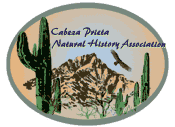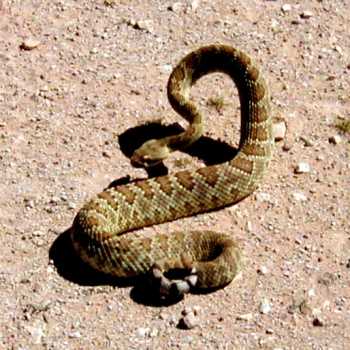
Cabeza Prieta Natural History Association
Sonoran Desert Reptiles
Crotalus scutulatus (Mojave rattlesnake)


|
Diet: rodents, birds, lizards
Size: 22" to 36" (56 to 91 cm) |
Identification: 24 - 51 in. (61-129 cm). Well-defined, light-edged dark gray to brown diamonds, ovals, or hexagons down middle of back; light scales of pattern usually entirely light-colored. (Dorsal blotches usually lack light borders at extreme southern end of range.) Ground color greenish gray, olive green, brownish, or yellowish. A white to yellowish stripe extends from behind the eye to a point behind the corner of the mouth (except at extreme southern end of range). Tail with contrasting light and dark rings: dark rings narrower than light rings. Enlarged scales on snout and usually between the supraoculars. Scales keeled, in 25 rows. Eats small mammals, (kangaroo rats, mice, ground squirrels, rabbits, hares), lizards, snakes, birds and their eggs. An extremely dangerous snake-often both neurotoxic and haemotoxic properties.
Comparison of Western diamondback (Crotalus atrox) and Mojave rattlesnake (Crotalus scutulatus): Both rattlesnakes have black and white bands at the tip of the tail. The bands are of approximately the same width on the Western diamondback. The white bands are twice as wide as the black bands on the Mojave rattlesnake.
References
|
Photo Credits:
Photo #1
Photo #2
Copyright Creative Commons
HTML & Programing by
Thomas R. Powell